Financial Management: Improving Financial Performance Analysis
VerifiedAdded on 2023/06/18
|12
|2815
|60
Report
AI Summary
This report provides a comprehensive overview of financial management, starting with the definition and importance of the concept. It delves into the main financial statements, including the income statement and balance sheet, explaining the use of ratios in financial management for performance comparison, planning, investor attraction, decision-making, and budget estimation. The report further discusses processes businesses can employ to enhance their financial performance, such as analyzing quick ratios, gross profit ratios, working capital, and current ratios. It emphasizes the role of these ratios in assessing liquidity, solvency, and profitability, ultimately contributing to informed financial decision-making and stability.

Importance of financial
management
management
Paraphrase This Document
Need a fresh take? Get an instant paraphrase of this document with our AI Paraphraser
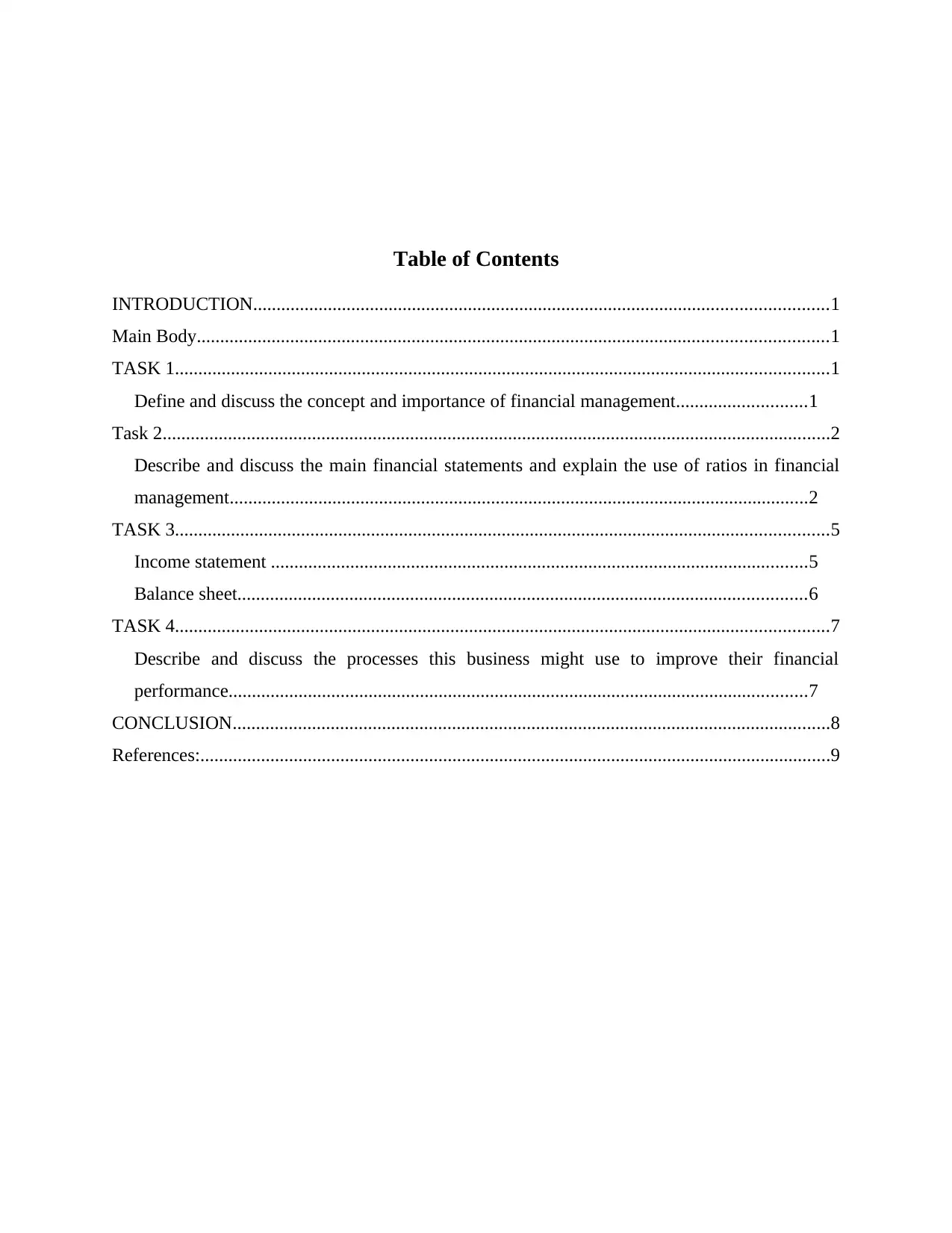
Table of Contents
INTRODUCTION...........................................................................................................................1
Main Body.......................................................................................................................................1
TASK 1............................................................................................................................................1
Define and discuss the concept and importance of financial management............................1
Task 2...............................................................................................................................................2
Describe and discuss the main financial statements and explain the use of ratios in financial
management............................................................................................................................2
TASK 3............................................................................................................................................5
Income statement ...................................................................................................................5
Balance sheet..........................................................................................................................6
TASK 4............................................................................................................................................7
Describe and discuss the processes this business might use to improve their financial
performance............................................................................................................................7
CONCLUSION................................................................................................................................8
References:.......................................................................................................................................9
INTRODUCTION...........................................................................................................................1
Main Body.......................................................................................................................................1
TASK 1............................................................................................................................................1
Define and discuss the concept and importance of financial management............................1
Task 2...............................................................................................................................................2
Describe and discuss the main financial statements and explain the use of ratios in financial
management............................................................................................................................2
TASK 3............................................................................................................................................5
Income statement ...................................................................................................................5
Balance sheet..........................................................................................................................6
TASK 4............................................................................................................................................7
Describe and discuss the processes this business might use to improve their financial
performance............................................................................................................................7
CONCLUSION................................................................................................................................8
References:.......................................................................................................................................9
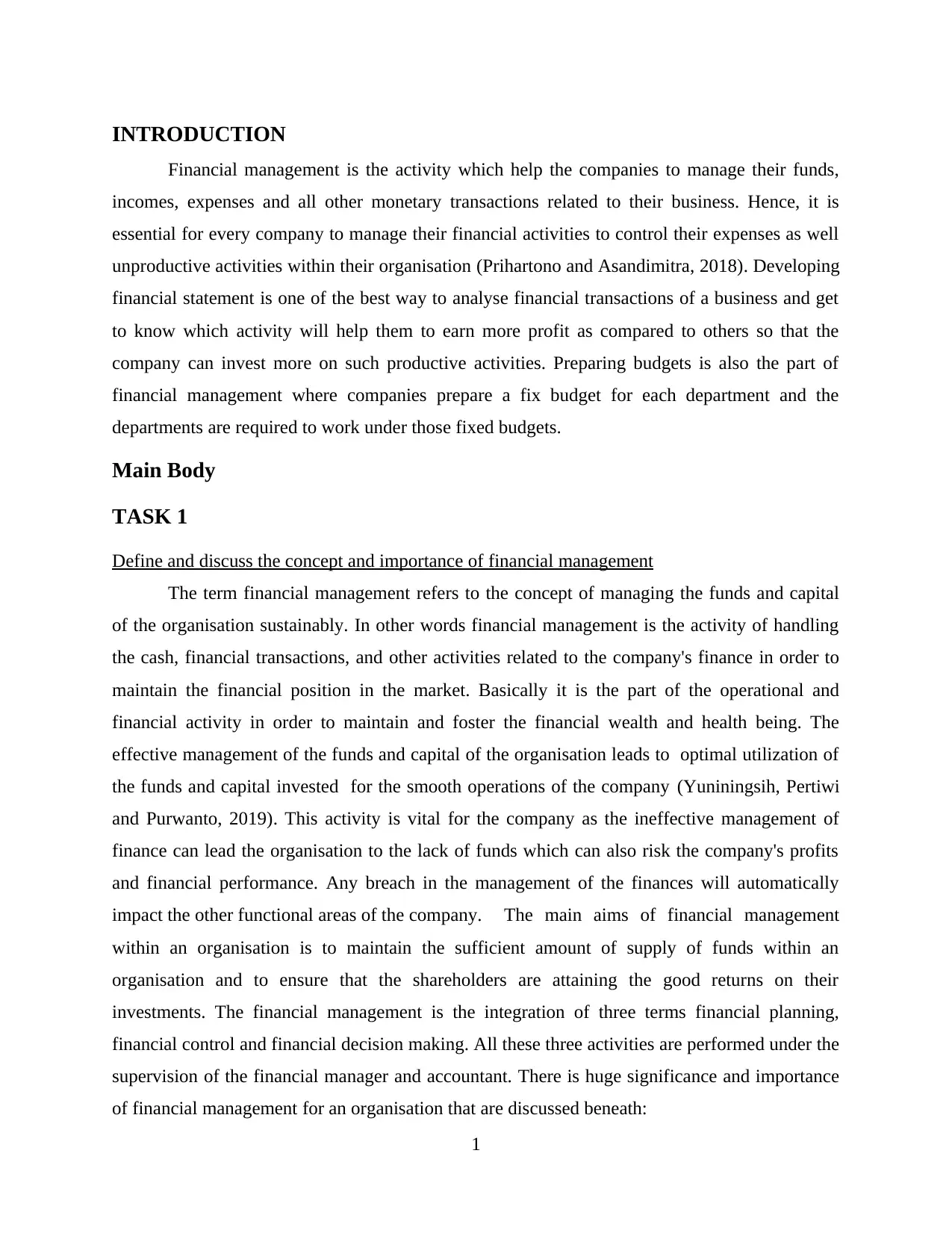
INTRODUCTION
Financial management is the activity which help the companies to manage their funds,
incomes, expenses and all other monetary transactions related to their business. Hence, it is
essential for every company to manage their financial activities to control their expenses as well
unproductive activities within their organisation (Prihartono and Asandimitra, 2018). Developing
financial statement is one of the best way to analyse financial transactions of a business and get
to know which activity will help them to earn more profit as compared to others so that the
company can invest more on such productive activities. Preparing budgets is also the part of
financial management where companies prepare a fix budget for each department and the
departments are required to work under those fixed budgets.
Main Body
TASK 1
Define and discuss the concept and importance of financial management
The term financial management refers to the concept of managing the funds and capital
of the organisation sustainably. In other words financial management is the activity of handling
the cash, financial transactions, and other activities related to the company's finance in order to
maintain the financial position in the market. Basically it is the part of the operational and
financial activity in order to maintain and foster the financial wealth and health being. The
effective management of the funds and capital of the organisation leads to optimal utilization of
the funds and capital invested for the smooth operations of the company (Yuniningsih, Pertiwi
and Purwanto, 2019). This activity is vital for the company as the ineffective management of
finance can lead the organisation to the lack of funds which can also risk the company's profits
and financial performance. Any breach in the management of the finances will automatically
impact the other functional areas of the company. The main aims of financial management
within an organisation is to maintain the sufficient amount of supply of funds within an
organisation and to ensure that the shareholders are attaining the good returns on their
investments. The financial management is the integration of three terms financial planning,
financial control and financial decision making. All these three activities are performed under the
supervision of the financial manager and accountant. There is huge significance and importance
of financial management for an organisation that are discussed beneath:
1
Financial management is the activity which help the companies to manage their funds,
incomes, expenses and all other monetary transactions related to their business. Hence, it is
essential for every company to manage their financial activities to control their expenses as well
unproductive activities within their organisation (Prihartono and Asandimitra, 2018). Developing
financial statement is one of the best way to analyse financial transactions of a business and get
to know which activity will help them to earn more profit as compared to others so that the
company can invest more on such productive activities. Preparing budgets is also the part of
financial management where companies prepare a fix budget for each department and the
departments are required to work under those fixed budgets.
Main Body
TASK 1
Define and discuss the concept and importance of financial management
The term financial management refers to the concept of managing the funds and capital
of the organisation sustainably. In other words financial management is the activity of handling
the cash, financial transactions, and other activities related to the company's finance in order to
maintain the financial position in the market. Basically it is the part of the operational and
financial activity in order to maintain and foster the financial wealth and health being. The
effective management of the funds and capital of the organisation leads to optimal utilization of
the funds and capital invested for the smooth operations of the company (Yuniningsih, Pertiwi
and Purwanto, 2019). This activity is vital for the company as the ineffective management of
finance can lead the organisation to the lack of funds which can also risk the company's profits
and financial performance. Any breach in the management of the finances will automatically
impact the other functional areas of the company. The main aims of financial management
within an organisation is to maintain the sufficient amount of supply of funds within an
organisation and to ensure that the shareholders are attaining the good returns on their
investments. The financial management is the integration of three terms financial planning,
financial control and financial decision making. All these three activities are performed under the
supervision of the financial manager and accountant. There is huge significance and importance
of financial management for an organisation that are discussed beneath:
1
⊘ This is a preview!⊘
Do you want full access?
Subscribe today to unlock all pages.

Trusted by 1+ million students worldwide
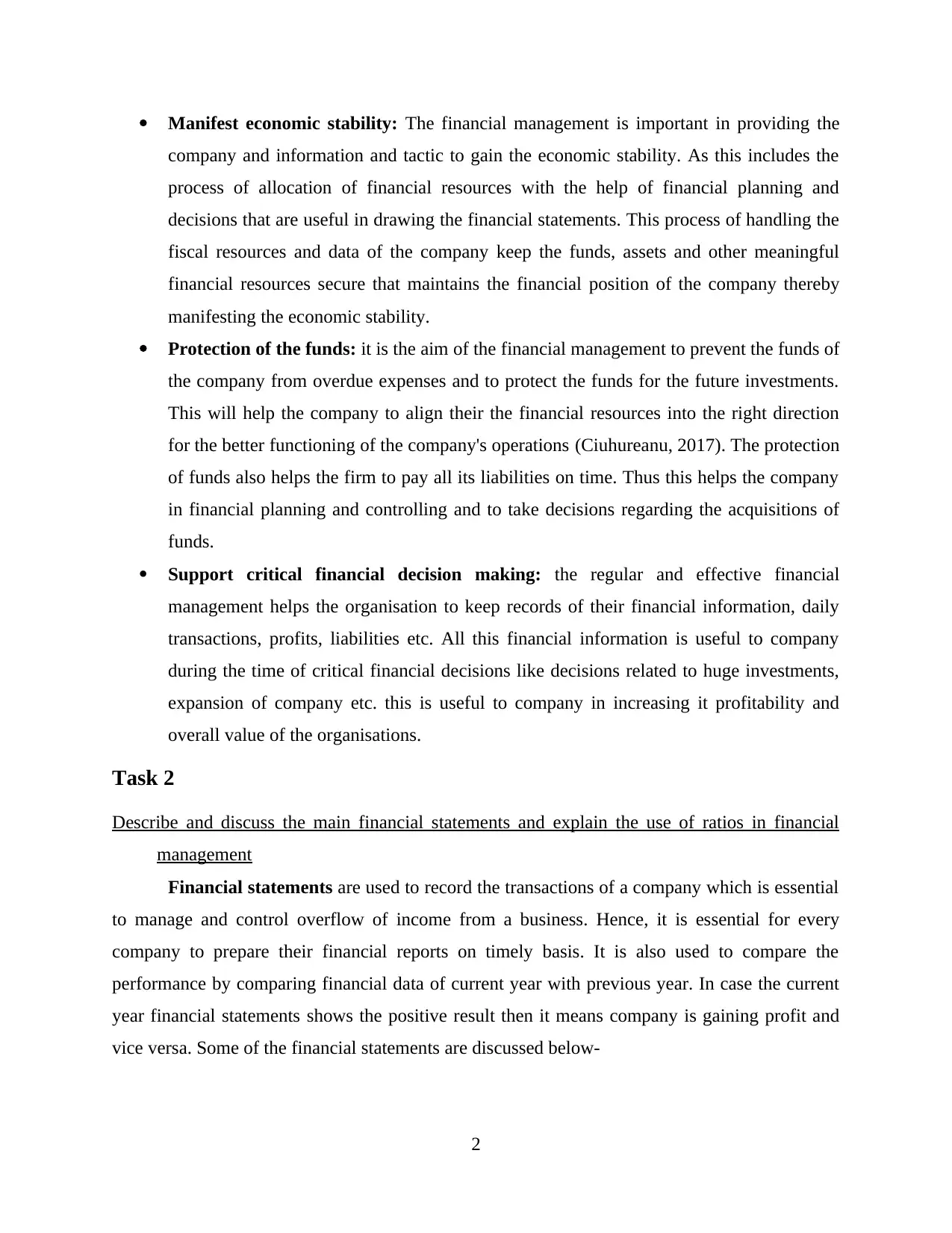
Manifest economic stability: The financial management is important in providing the
company and information and tactic to gain the economic stability. As this includes the
process of allocation of financial resources with the help of financial planning and
decisions that are useful in drawing the financial statements. This process of handling the
fiscal resources and data of the company keep the funds, assets and other meaningful
financial resources secure that maintains the financial position of the company thereby
manifesting the economic stability.
Protection of the funds: it is the aim of the financial management to prevent the funds of
the company from overdue expenses and to protect the funds for the future investments.
This will help the company to align their the financial resources into the right direction
for the better functioning of the company's operations (Ciuhureanu, 2017). The protection
of funds also helps the firm to pay all its liabilities on time. Thus this helps the company
in financial planning and controlling and to take decisions regarding the acquisitions of
funds.
Support critical financial decision making: the regular and effective financial
management helps the organisation to keep records of their financial information, daily
transactions, profits, liabilities etc. All this financial information is useful to company
during the time of critical financial decisions like decisions related to huge investments,
expansion of company etc. this is useful to company in increasing it profitability and
overall value of the organisations.
Task 2
Describe and discuss the main financial statements and explain the use of ratios in financial
management
Financial statements are used to record the transactions of a company which is essential
to manage and control overflow of income from a business. Hence, it is essential for every
company to prepare their financial reports on timely basis. It is also used to compare the
performance by comparing financial data of current year with previous year. In case the current
year financial statements shows the positive result then it means company is gaining profit and
vice versa. Some of the financial statements are discussed below-
2
company and information and tactic to gain the economic stability. As this includes the
process of allocation of financial resources with the help of financial planning and
decisions that are useful in drawing the financial statements. This process of handling the
fiscal resources and data of the company keep the funds, assets and other meaningful
financial resources secure that maintains the financial position of the company thereby
manifesting the economic stability.
Protection of the funds: it is the aim of the financial management to prevent the funds of
the company from overdue expenses and to protect the funds for the future investments.
This will help the company to align their the financial resources into the right direction
for the better functioning of the company's operations (Ciuhureanu, 2017). The protection
of funds also helps the firm to pay all its liabilities on time. Thus this helps the company
in financial planning and controlling and to take decisions regarding the acquisitions of
funds.
Support critical financial decision making: the regular and effective financial
management helps the organisation to keep records of their financial information, daily
transactions, profits, liabilities etc. All this financial information is useful to company
during the time of critical financial decisions like decisions related to huge investments,
expansion of company etc. this is useful to company in increasing it profitability and
overall value of the organisations.
Task 2
Describe and discuss the main financial statements and explain the use of ratios in financial
management
Financial statements are used to record the transactions of a company which is essential
to manage and control overflow of income from a business. Hence, it is essential for every
company to prepare their financial reports on timely basis. It is also used to compare the
performance by comparing financial data of current year with previous year. In case the current
year financial statements shows the positive result then it means company is gaining profit and
vice versa. Some of the financial statements are discussed below-
2
Paraphrase This Document
Need a fresh take? Get an instant paraphrase of this document with our AI Paraphraser
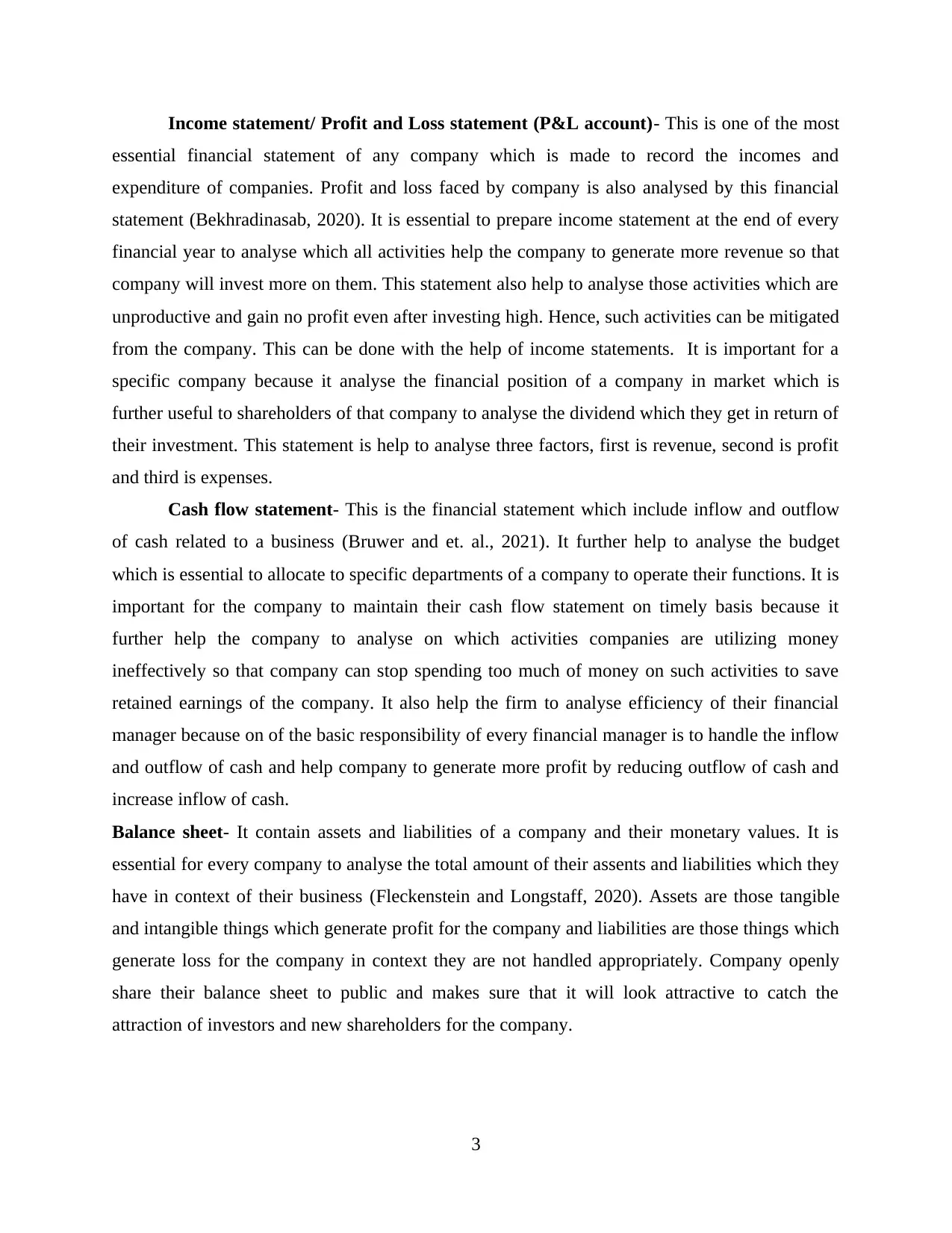
Income statement/ Profit and Loss statement (P&L account)- This is one of the most
essential financial statement of any company which is made to record the incomes and
expenditure of companies. Profit and loss faced by company is also analysed by this financial
statement (Bekhradinasab, 2020). It is essential to prepare income statement at the end of every
financial year to analyse which all activities help the company to generate more revenue so that
company will invest more on them. This statement also help to analyse those activities which are
unproductive and gain no profit even after investing high. Hence, such activities can be mitigated
from the company. This can be done with the help of income statements. It is important for a
specific company because it analyse the financial position of a company in market which is
further useful to shareholders of that company to analyse the dividend which they get in return of
their investment. This statement is help to analyse three factors, first is revenue, second is profit
and third is expenses.
Cash flow statement- This is the financial statement which include inflow and outflow
of cash related to a business (Bruwer and et. al., 2021). It further help to analyse the budget
which is essential to allocate to specific departments of a company to operate their functions. It is
important for the company to maintain their cash flow statement on timely basis because it
further help the company to analyse on which activities companies are utilizing money
ineffectively so that company can stop spending too much of money on such activities to save
retained earnings of the company. It also help the firm to analyse efficiency of their financial
manager because on of the basic responsibility of every financial manager is to handle the inflow
and outflow of cash and help company to generate more profit by reducing outflow of cash and
increase inflow of cash.
Balance sheet- It contain assets and liabilities of a company and their monetary values. It is
essential for every company to analyse the total amount of their assents and liabilities which they
have in context of their business (Fleckenstein and Longstaff, 2020). Assets are those tangible
and intangible things which generate profit for the company and liabilities are those things which
generate loss for the company in context they are not handled appropriately. Company openly
share their balance sheet to public and makes sure that it will look attractive to catch the
attraction of investors and new shareholders for the company.
3
essential financial statement of any company which is made to record the incomes and
expenditure of companies. Profit and loss faced by company is also analysed by this financial
statement (Bekhradinasab, 2020). It is essential to prepare income statement at the end of every
financial year to analyse which all activities help the company to generate more revenue so that
company will invest more on them. This statement also help to analyse those activities which are
unproductive and gain no profit even after investing high. Hence, such activities can be mitigated
from the company. This can be done with the help of income statements. It is important for a
specific company because it analyse the financial position of a company in market which is
further useful to shareholders of that company to analyse the dividend which they get in return of
their investment. This statement is help to analyse three factors, first is revenue, second is profit
and third is expenses.
Cash flow statement- This is the financial statement which include inflow and outflow
of cash related to a business (Bruwer and et. al., 2021). It further help to analyse the budget
which is essential to allocate to specific departments of a company to operate their functions. It is
important for the company to maintain their cash flow statement on timely basis because it
further help the company to analyse on which activities companies are utilizing money
ineffectively so that company can stop spending too much of money on such activities to save
retained earnings of the company. It also help the firm to analyse efficiency of their financial
manager because on of the basic responsibility of every financial manager is to handle the inflow
and outflow of cash and help company to generate more profit by reducing outflow of cash and
increase inflow of cash.
Balance sheet- It contain assets and liabilities of a company and their monetary values. It is
essential for every company to analyse the total amount of their assents and liabilities which they
have in context of their business (Fleckenstein and Longstaff, 2020). Assets are those tangible
and intangible things which generate profit for the company and liabilities are those things which
generate loss for the company in context they are not handled appropriately. Company openly
share their balance sheet to public and makes sure that it will look attractive to catch the
attraction of investors and new shareholders for the company.
3
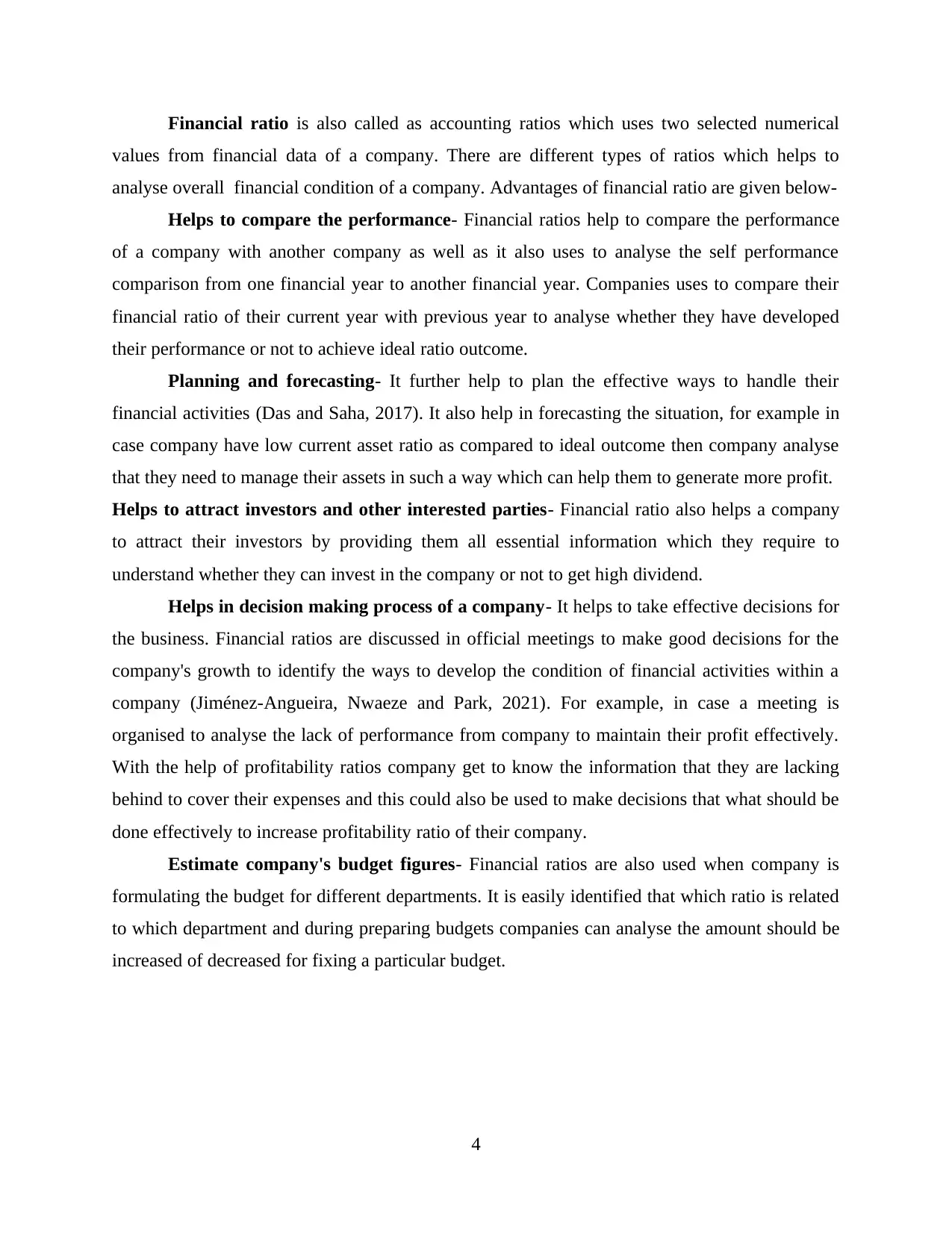
Financial ratio is also called as accounting ratios which uses two selected numerical
values from financial data of a company. There are different types of ratios which helps to
analyse overall financial condition of a company. Advantages of financial ratio are given below-
Helps to compare the performance- Financial ratios help to compare the performance
of a company with another company as well as it also uses to analyse the self performance
comparison from one financial year to another financial year. Companies uses to compare their
financial ratio of their current year with previous year to analyse whether they have developed
their performance or not to achieve ideal ratio outcome.
Planning and forecasting- It further help to plan the effective ways to handle their
financial activities (Das and Saha, 2017). It also help in forecasting the situation, for example in
case company have low current asset ratio as compared to ideal outcome then company analyse
that they need to manage their assets in such a way which can help them to generate more profit.
Helps to attract investors and other interested parties- Financial ratio also helps a company
to attract their investors by providing them all essential information which they require to
understand whether they can invest in the company or not to get high dividend.
Helps in decision making process of a company- It helps to take effective decisions for
the business. Financial ratios are discussed in official meetings to make good decisions for the
company's growth to identify the ways to develop the condition of financial activities within a
company (Jiménez-Angueira, Nwaeze and Park, 2021). For example, in case a meeting is
organised to analyse the lack of performance from company to maintain their profit effectively.
With the help of profitability ratios company get to know the information that they are lacking
behind to cover their expenses and this could also be used to make decisions that what should be
done effectively to increase profitability ratio of their company.
Estimate company's budget figures- Financial ratios are also used when company is
formulating the budget for different departments. It is easily identified that which ratio is related
to which department and during preparing budgets companies can analyse the amount should be
increased of decreased for fixing a particular budget.
4
values from financial data of a company. There are different types of ratios which helps to
analyse overall financial condition of a company. Advantages of financial ratio are given below-
Helps to compare the performance- Financial ratios help to compare the performance
of a company with another company as well as it also uses to analyse the self performance
comparison from one financial year to another financial year. Companies uses to compare their
financial ratio of their current year with previous year to analyse whether they have developed
their performance or not to achieve ideal ratio outcome.
Planning and forecasting- It further help to plan the effective ways to handle their
financial activities (Das and Saha, 2017). It also help in forecasting the situation, for example in
case company have low current asset ratio as compared to ideal outcome then company analyse
that they need to manage their assets in such a way which can help them to generate more profit.
Helps to attract investors and other interested parties- Financial ratio also helps a company
to attract their investors by providing them all essential information which they require to
understand whether they can invest in the company or not to get high dividend.
Helps in decision making process of a company- It helps to take effective decisions for
the business. Financial ratios are discussed in official meetings to make good decisions for the
company's growth to identify the ways to develop the condition of financial activities within a
company (Jiménez-Angueira, Nwaeze and Park, 2021). For example, in case a meeting is
organised to analyse the lack of performance from company to maintain their profit effectively.
With the help of profitability ratios company get to know the information that they are lacking
behind to cover their expenses and this could also be used to make decisions that what should be
done effectively to increase profitability ratio of their company.
Estimate company's budget figures- Financial ratios are also used when company is
formulating the budget for different departments. It is easily identified that which ratio is related
to which department and during preparing budgets companies can analyse the amount should be
increased of decreased for fixing a particular budget.
4
⊘ This is a preview!⊘
Do you want full access?
Subscribe today to unlock all pages.

Trusted by 1+ million students worldwide
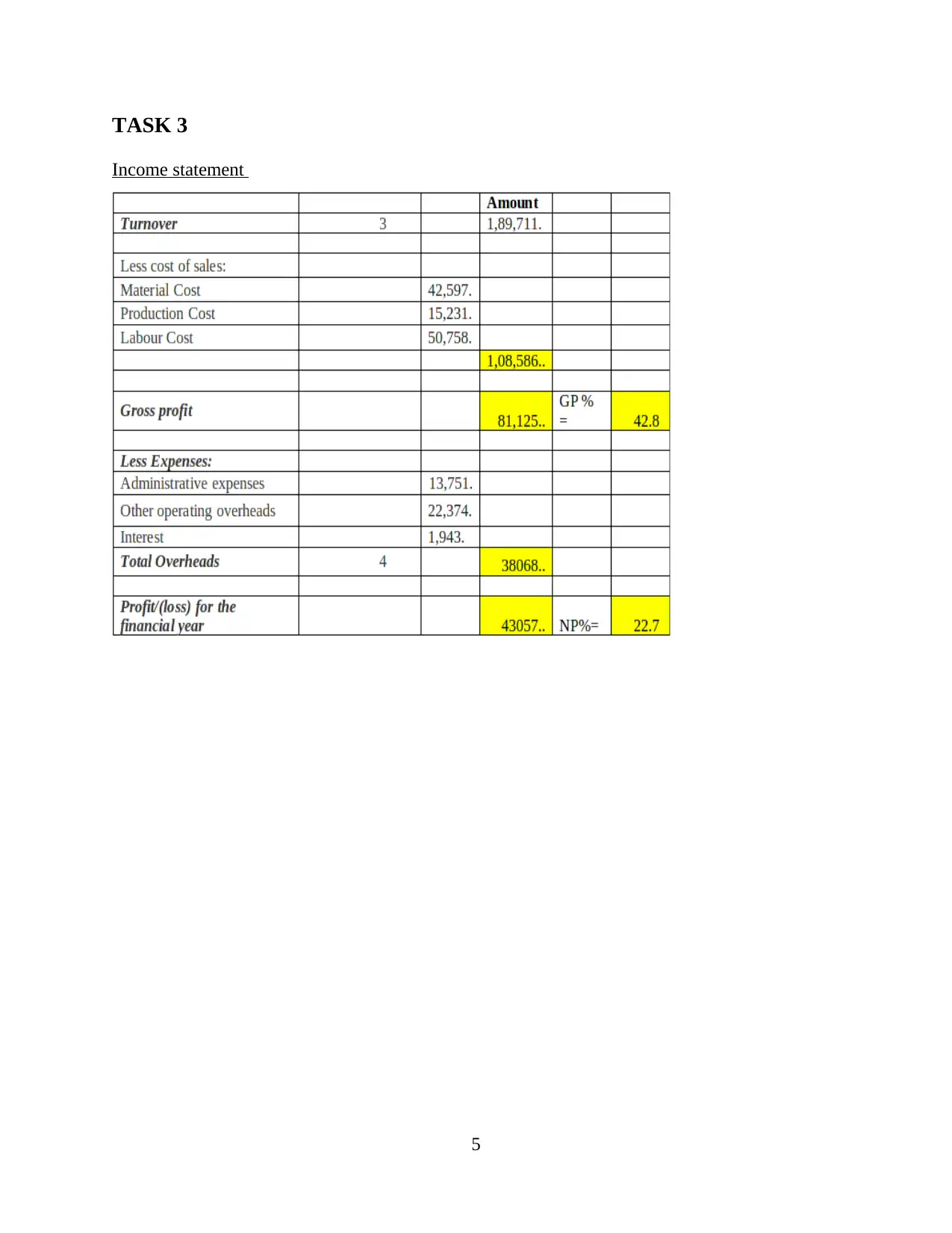
TASK 3
Income statement
5
Income statement
5
Paraphrase This Document
Need a fresh take? Get an instant paraphrase of this document with our AI Paraphraser
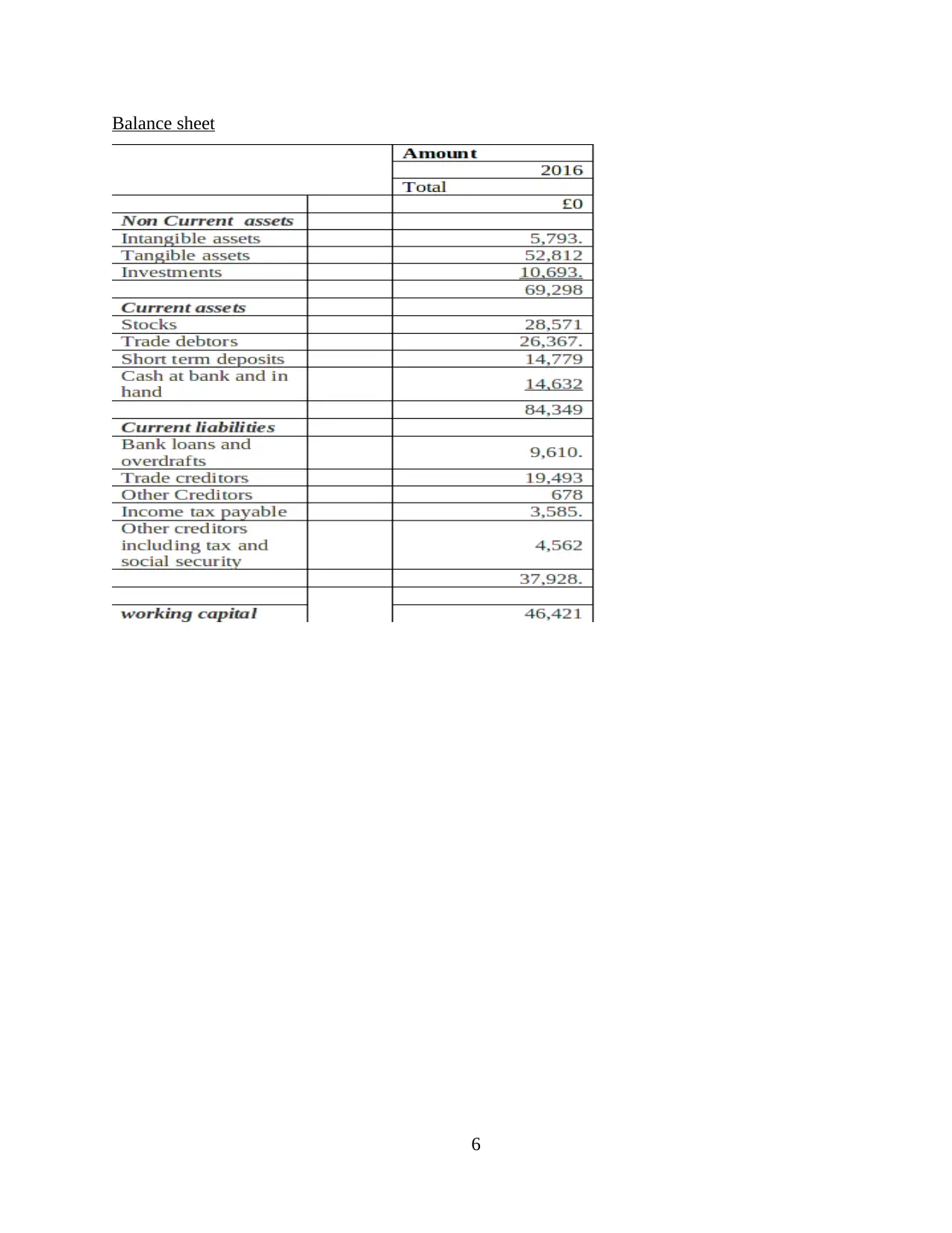
Balance sheet
6
6
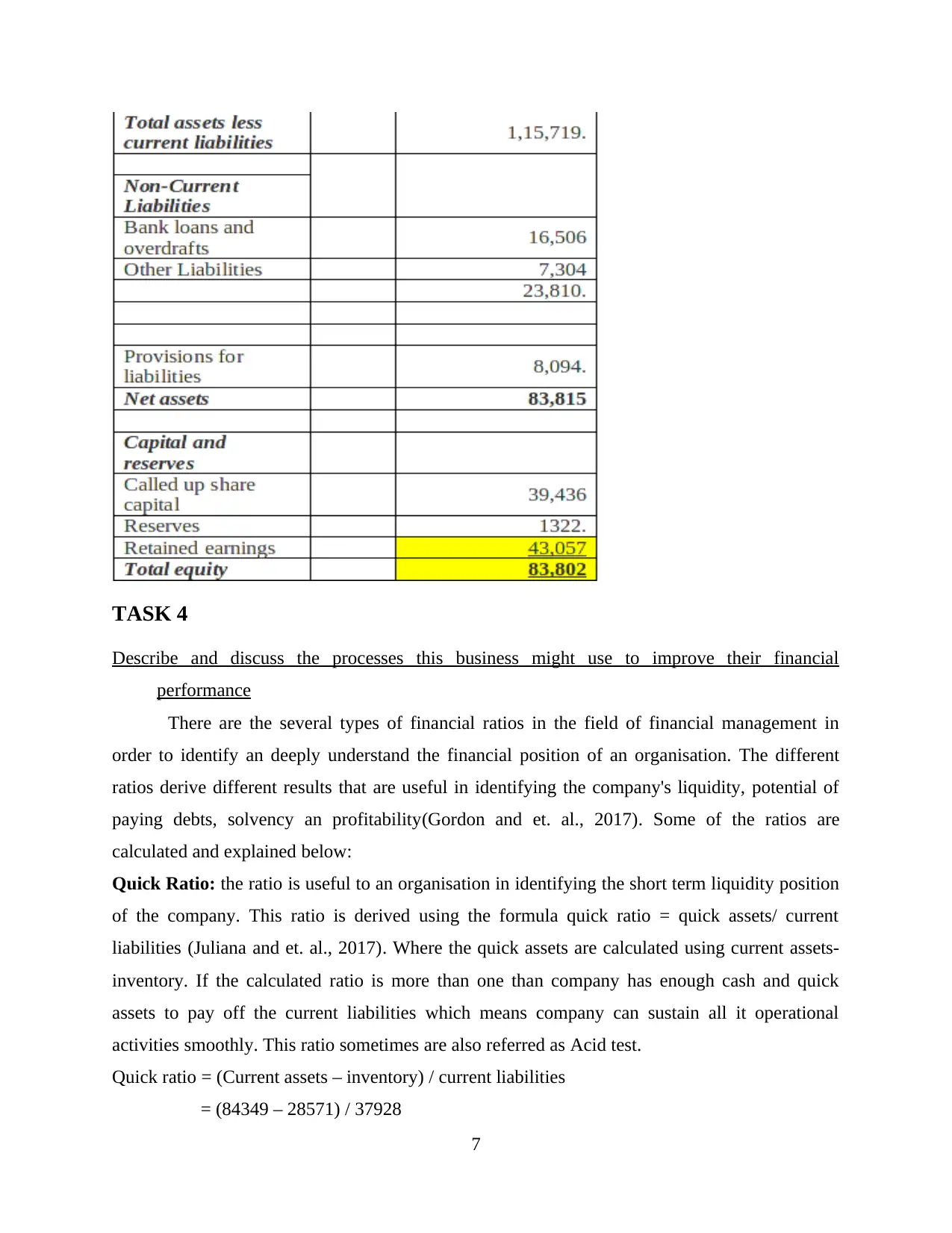
TASK 4
Describe and discuss the processes this business might use to improve their financial
performance
There are the several types of financial ratios in the field of financial management in
order to identify an deeply understand the financial position of an organisation. The different
ratios derive different results that are useful in identifying the company's liquidity, potential of
paying debts, solvency an profitability(Gordon and et. al., 2017). Some of the ratios are
calculated and explained below:
Quick Ratio: the ratio is useful to an organisation in identifying the short term liquidity position
of the company. This ratio is derived using the formula quick ratio = quick assets/ current
liabilities (Juliana and et. al., 2017). Where the quick assets are calculated using current assets-
inventory. If the calculated ratio is more than one than company has enough cash and quick
assets to pay off the current liabilities which means company can sustain all it operational
activities smoothly. This ratio sometimes are also referred as Acid test.
Quick ratio = (Current assets – inventory) / current liabilities
= (84349 – 28571) / 37928
7
Describe and discuss the processes this business might use to improve their financial
performance
There are the several types of financial ratios in the field of financial management in
order to identify an deeply understand the financial position of an organisation. The different
ratios derive different results that are useful in identifying the company's liquidity, potential of
paying debts, solvency an profitability(Gordon and et. al., 2017). Some of the ratios are
calculated and explained below:
Quick Ratio: the ratio is useful to an organisation in identifying the short term liquidity position
of the company. This ratio is derived using the formula quick ratio = quick assets/ current
liabilities (Juliana and et. al., 2017). Where the quick assets are calculated using current assets-
inventory. If the calculated ratio is more than one than company has enough cash and quick
assets to pay off the current liabilities which means company can sustain all it operational
activities smoothly. This ratio sometimes are also referred as Acid test.
Quick ratio = (Current assets – inventory) / current liabilities
= (84349 – 28571) / 37928
7
⊘ This is a preview!⊘
Do you want full access?
Subscribe today to unlock all pages.

Trusted by 1+ million students worldwide
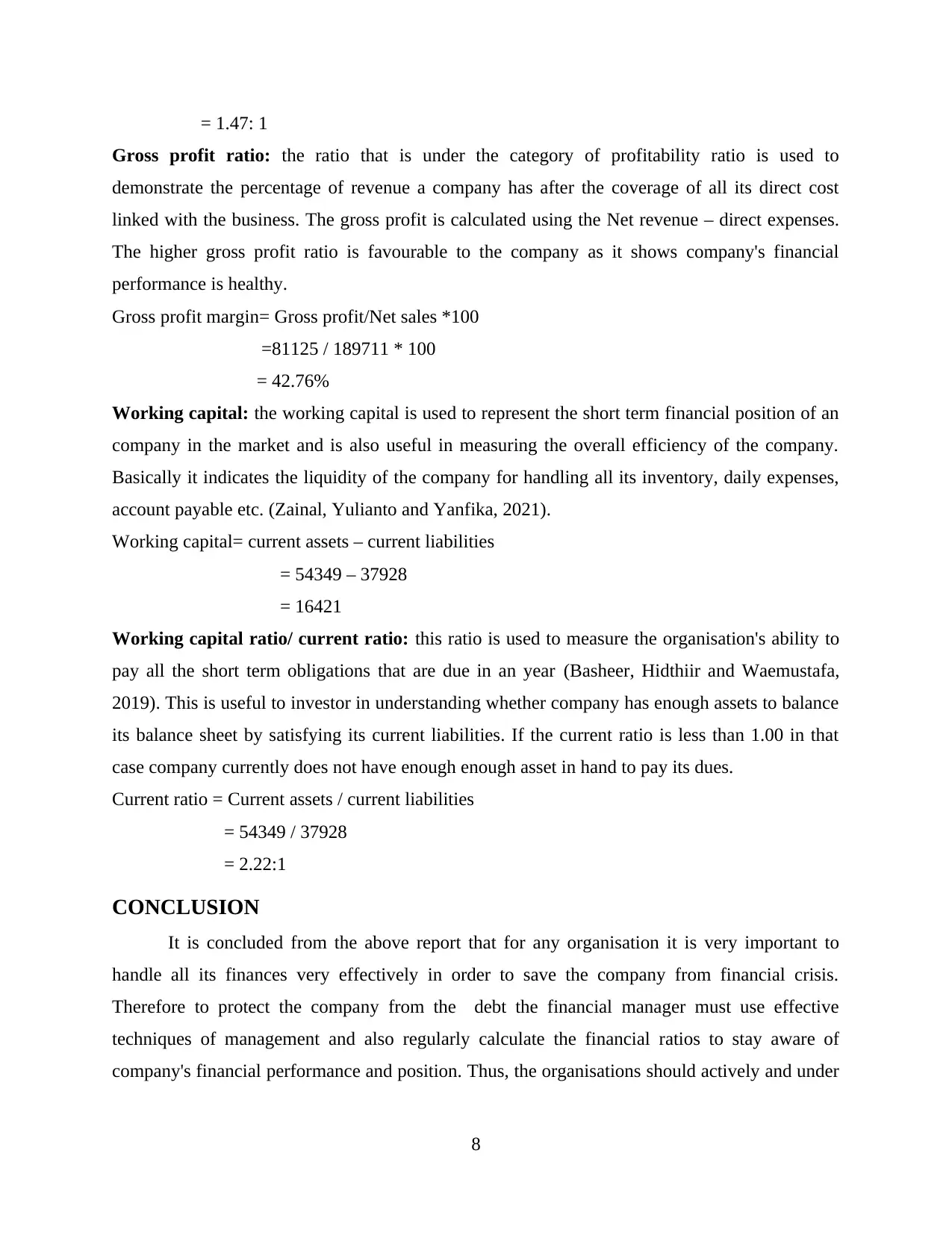
= 1.47: 1
Gross profit ratio: the ratio that is under the category of profitability ratio is used to
demonstrate the percentage of revenue a company has after the coverage of all its direct cost
linked with the business. The gross profit is calculated using the Net revenue – direct expenses.
The higher gross profit ratio is favourable to the company as it shows company's financial
performance is healthy.
Gross profit margin= Gross profit/Net sales *100
=81125 / 189711 * 100
= 42.76%
Working capital: the working capital is used to represent the short term financial position of an
company in the market and is also useful in measuring the overall efficiency of the company.
Basically it indicates the liquidity of the company for handling all its inventory, daily expenses,
account payable etc. (Zainal, Yulianto and Yanfika, 2021).
Working capital= current assets – current liabilities
= 54349 – 37928
= 16421
Working capital ratio/ current ratio: this ratio is used to measure the organisation's ability to
pay all the short term obligations that are due in an year (Basheer, Hidthiir and Waemustafa,
2019). This is useful to investor in understanding whether company has enough assets to balance
its balance sheet by satisfying its current liabilities. If the current ratio is less than 1.00 in that
case company currently does not have enough enough asset in hand to pay its dues.
Current ratio = Current assets / current liabilities
= 54349 / 37928
= 2.22:1
CONCLUSION
It is concluded from the above report that for any organisation it is very important to
handle all its finances very effectively in order to save the company from financial crisis.
Therefore to protect the company from the debt the financial manager must use effective
techniques of management and also regularly calculate the financial ratios to stay aware of
company's financial performance and position. Thus, the organisations should actively and under
8
Gross profit ratio: the ratio that is under the category of profitability ratio is used to
demonstrate the percentage of revenue a company has after the coverage of all its direct cost
linked with the business. The gross profit is calculated using the Net revenue – direct expenses.
The higher gross profit ratio is favourable to the company as it shows company's financial
performance is healthy.
Gross profit margin= Gross profit/Net sales *100
=81125 / 189711 * 100
= 42.76%
Working capital: the working capital is used to represent the short term financial position of an
company in the market and is also useful in measuring the overall efficiency of the company.
Basically it indicates the liquidity of the company for handling all its inventory, daily expenses,
account payable etc. (Zainal, Yulianto and Yanfika, 2021).
Working capital= current assets – current liabilities
= 54349 – 37928
= 16421
Working capital ratio/ current ratio: this ratio is used to measure the organisation's ability to
pay all the short term obligations that are due in an year (Basheer, Hidthiir and Waemustafa,
2019). This is useful to investor in understanding whether company has enough assets to balance
its balance sheet by satisfying its current liabilities. If the current ratio is less than 1.00 in that
case company currently does not have enough enough asset in hand to pay its dues.
Current ratio = Current assets / current liabilities
= 54349 / 37928
= 2.22:1
CONCLUSION
It is concluded from the above report that for any organisation it is very important to
handle all its finances very effectively in order to save the company from financial crisis.
Therefore to protect the company from the debt the financial manager must use effective
techniques of management and also regularly calculate the financial ratios to stay aware of
company's financial performance and position. Thus, the organisations should actively and under
8
Paraphrase This Document
Need a fresh take? Get an instant paraphrase of this document with our AI Paraphraser

the all the rules and regulation perform their financial management activities to stay safe and also
to act ethically.
9
to act ethically.
9
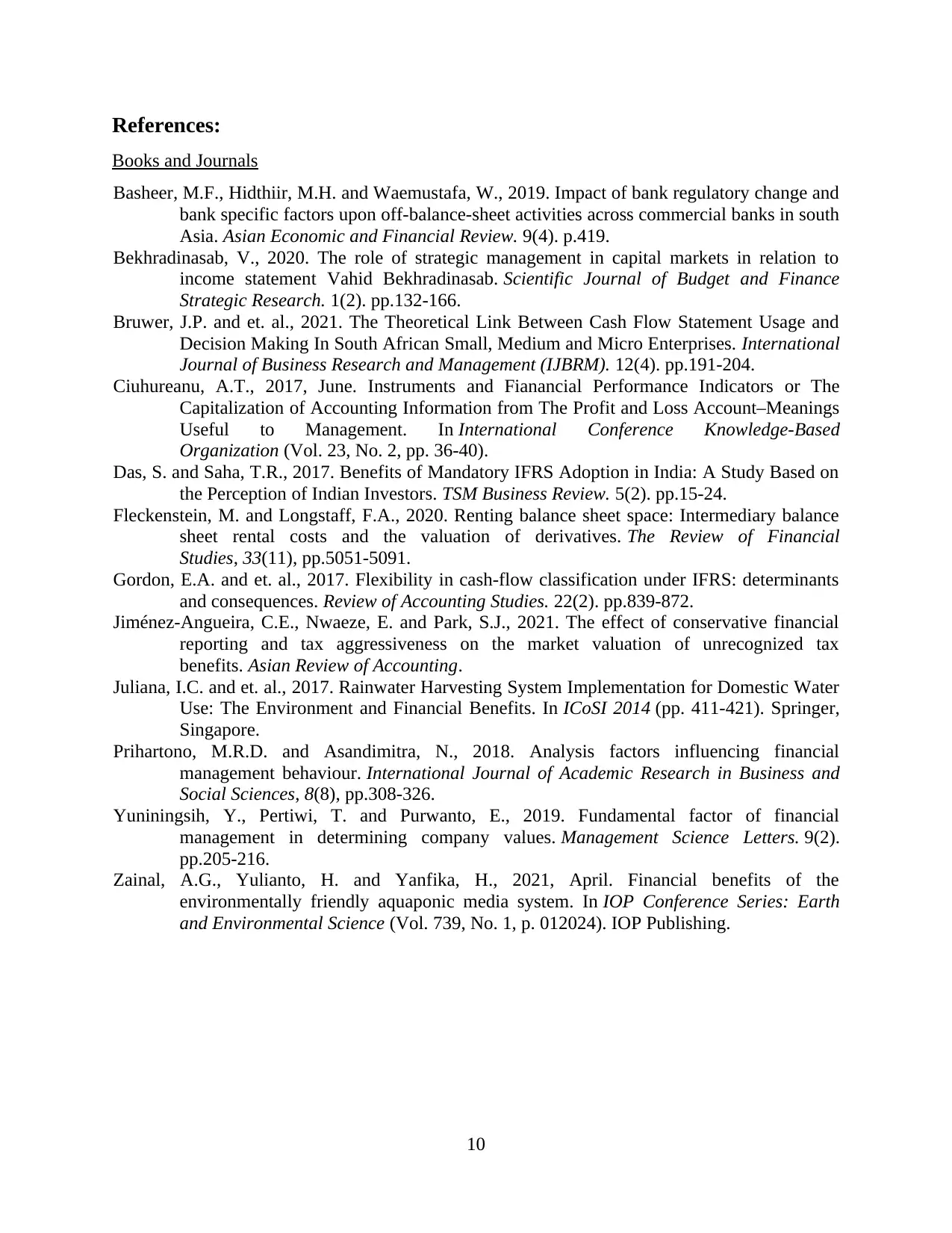
References:
Books and Journals
Basheer, M.F., Hidthiir, M.H. and Waemustafa, W., 2019. Impact of bank regulatory change and
bank specific factors upon off-balance-sheet activities across commercial banks in south
Asia. Asian Economic and Financial Review. 9(4). p.419.
Bekhradinasab, V., 2020. The role of strategic management in capital markets in relation to
income statement Vahid Bekhradinasab. Scientific Journal of Budget and Finance
Strategic Research. 1(2). pp.132-166.
Bruwer, J.P. and et. al., 2021. The Theoretical Link Between Cash Flow Statement Usage and
Decision Making In South African Small, Medium and Micro Enterprises. International
Journal of Business Research and Management (IJBRM). 12(4). pp.191-204.
Ciuhureanu, A.T., 2017, June. Instruments and Fianancial Performance Indicators or The
Capitalization of Accounting Information from The Profit and Loss Account–Meanings
Useful to Management. In International Conference Knowledge-Based
Organization (Vol. 23, No. 2, pp. 36-40).
Das, S. and Saha, T.R., 2017. Benefits of Mandatory IFRS Adoption in India: A Study Based on
the Perception of Indian Investors. TSM Business Review. 5(2). pp.15-24.
Fleckenstein, M. and Longstaff, F.A., 2020. Renting balance sheet space: Intermediary balance
sheet rental costs and the valuation of derivatives. The Review of Financial
Studies, 33(11), pp.5051-5091.
Gordon, E.A. and et. al., 2017. Flexibility in cash-flow classification under IFRS: determinants
and consequences. Review of Accounting Studies. 22(2). pp.839-872.
Jiménez-Angueira, C.E., Nwaeze, E. and Park, S.J., 2021. The effect of conservative financial
reporting and tax aggressiveness on the market valuation of unrecognized tax
benefits. Asian Review of Accounting.
Juliana, I.C. and et. al., 2017. Rainwater Harvesting System Implementation for Domestic Water
Use: The Environment and Financial Benefits. In ICoSI 2014 (pp. 411-421). Springer,
Singapore.
Prihartono, M.R.D. and Asandimitra, N., 2018. Analysis factors influencing financial
management behaviour. International Journal of Academic Research in Business and
Social Sciences, 8(8), pp.308-326.
Yuniningsih, Y., Pertiwi, T. and Purwanto, E., 2019. Fundamental factor of financial
management in determining company values. Management Science Letters. 9(2).
pp.205-216.
Zainal, A.G., Yulianto, H. and Yanfika, H., 2021, April. Financial benefits of the
environmentally friendly aquaponic media system. In IOP Conference Series: Earth
and Environmental Science (Vol. 739, No. 1, p. 012024). IOP Publishing.
10
Books and Journals
Basheer, M.F., Hidthiir, M.H. and Waemustafa, W., 2019. Impact of bank regulatory change and
bank specific factors upon off-balance-sheet activities across commercial banks in south
Asia. Asian Economic and Financial Review. 9(4). p.419.
Bekhradinasab, V., 2020. The role of strategic management in capital markets in relation to
income statement Vahid Bekhradinasab. Scientific Journal of Budget and Finance
Strategic Research. 1(2). pp.132-166.
Bruwer, J.P. and et. al., 2021. The Theoretical Link Between Cash Flow Statement Usage and
Decision Making In South African Small, Medium and Micro Enterprises. International
Journal of Business Research and Management (IJBRM). 12(4). pp.191-204.
Ciuhureanu, A.T., 2017, June. Instruments and Fianancial Performance Indicators or The
Capitalization of Accounting Information from The Profit and Loss Account–Meanings
Useful to Management. In International Conference Knowledge-Based
Organization (Vol. 23, No. 2, pp. 36-40).
Das, S. and Saha, T.R., 2017. Benefits of Mandatory IFRS Adoption in India: A Study Based on
the Perception of Indian Investors. TSM Business Review. 5(2). pp.15-24.
Fleckenstein, M. and Longstaff, F.A., 2020. Renting balance sheet space: Intermediary balance
sheet rental costs and the valuation of derivatives. The Review of Financial
Studies, 33(11), pp.5051-5091.
Gordon, E.A. and et. al., 2017. Flexibility in cash-flow classification under IFRS: determinants
and consequences. Review of Accounting Studies. 22(2). pp.839-872.
Jiménez-Angueira, C.E., Nwaeze, E. and Park, S.J., 2021. The effect of conservative financial
reporting and tax aggressiveness on the market valuation of unrecognized tax
benefits. Asian Review of Accounting.
Juliana, I.C. and et. al., 2017. Rainwater Harvesting System Implementation for Domestic Water
Use: The Environment and Financial Benefits. In ICoSI 2014 (pp. 411-421). Springer,
Singapore.
Prihartono, M.R.D. and Asandimitra, N., 2018. Analysis factors influencing financial
management behaviour. International Journal of Academic Research in Business and
Social Sciences, 8(8), pp.308-326.
Yuniningsih, Y., Pertiwi, T. and Purwanto, E., 2019. Fundamental factor of financial
management in determining company values. Management Science Letters. 9(2).
pp.205-216.
Zainal, A.G., Yulianto, H. and Yanfika, H., 2021, April. Financial benefits of the
environmentally friendly aquaponic media system. In IOP Conference Series: Earth
and Environmental Science (Vol. 739, No. 1, p. 012024). IOP Publishing.
10
⊘ This is a preview!⊘
Do you want full access?
Subscribe today to unlock all pages.

Trusted by 1+ million students worldwide
1 out of 12
Related Documents
Your All-in-One AI-Powered Toolkit for Academic Success.
+13062052269
info@desklib.com
Available 24*7 on WhatsApp / Email
![[object Object]](/_next/static/media/star-bottom.7253800d.svg)
Unlock your academic potential
Copyright © 2020–2025 A2Z Services. All Rights Reserved. Developed and managed by ZUCOL.



